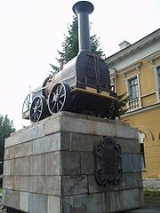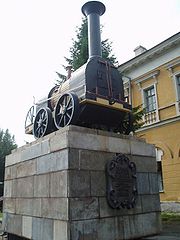
Cherepanov
Encyclopedia

Russia
Russia or , officially known as both Russia and the Russian Federation , is a country in northern Eurasia. It is a federal semi-presidential republic, comprising 83 federal subjects...
n inventors and industrial engineers
Industrial engineering
Industrial engineering is a branch of engineering dealing with the optimization of complex processes or systems. It is concerned with the development, improvement, implementation and evaluation of integrated systems of people, money, knowledge, information, equipment, energy, materials, analysis...
, father and son. They were serf
SERF
A spin exchange relaxation-free magnetometer is a type of magnetometer developed at Princeton University in the early 2000s. SERF magnetometers measure magnetic fields by using lasers to detect the interaction between alkali metal atoms in a vapor and the magnetic field.The name for the technique...
s of the Demidov
Demidov
The Demidov family, also Demidoff, were an influential Russian merchant, industrialist and later chivalry family, possibly second only to the Tsar himself in wealth during the late 18th and early 19th centuries.-History:...
s – a famous family of factory owners. In 1810s, Yefim built a progressive machine-building plant, equipped with a full range of innovative metal-cutting lathe
Lathe (metal)
A metal lathe or metalworking lathe is a large class of lathes designed for precisely machining relatively hard materials. They were originally designed to machine metals; however, with the advent of plastics and other materials, and with their inherent versatility, they are used in a wide range of...
s (such as screw-cutters, gear-cutting serrating machines and others). From 1822 until his death, Yefim had been chief mechanic of all the factories in the town of Nizhny Tagil
Nizhny Tagil
Nizhny Tagil is a city in Sverdlovsk Oblast, Russia, situated east of the virtual border between Europe and Asia. Population: -History:...
. His son Miron was his apprentice and in 1819 was appointed his deputy and eventually replaced his father after his death.
Cherepanovs significally improved the machinery that had been used in blast-furnace and gold
Gold
Gold is a chemical element with the symbol Au and an atomic number of 79. Gold is a dense, soft, shiny, malleable and ductile metal. Pure gold has a bright yellow color and luster traditionally considered attractive, which it maintains without oxidizing in air or water. Chemically, gold is a...
-mining industries, iron
Iron
Iron is a chemical element with the symbol Fe and atomic number 26. It is a metal in the first transition series. It is the most common element forming the planet Earth as a whole, forming much of Earth's outer and inner core. It is the fourth most common element in the Earth's crust...
and copper
Copper
Copper is a chemical element with the symbol Cu and atomic number 29. It is a ductile metal with very high thermal and electrical conductivity. Pure copper is soft and malleable; an exposed surface has a reddish-orange tarnish...
works, sawmill
Sawmill
A sawmill is a facility where logs are cut into boards.-Sawmill process:A sawmill's basic operation is much like those of hundreds of years ago; a log enters on one end and dimensional lumber exits on the other end....
s and flourmills. However, the most interesting aspect of the Cherepanovs' work were steam engine
Steam engine
A steam engine is a heat engine that performs mechanical work using steam as its working fluid.Steam engines are external combustion engines, where the working fluid is separate from the combustion products. Non-combustion heat sources such as solar power, nuclear power or geothermal energy may be...
s which they stubbornly tried to introduce into industrial production. Since 1820, the Cherepanovs had built about 20 steam engines (ranging from 2 to 60 h.p.). In 1833-34 they built the first Russian steam locomotive
Steam locomotive
A steam locomotive is a railway locomotive that produces its power through a steam engine. These locomotives are fueled by burning some combustible material, usually coal, wood or oil, to produce steam in a boiler, which drives the steam engine...
, and then in 1835 – the second one, more powerful. They also built a cast-iron railroad from one of their factories to the copper mine
Mining
Mining is the extraction of valuable minerals or other geological materials from the earth, from an ore body, vein or seam. The term also includes the removal of soil. Materials recovered by mining include base metals, precious metals, iron, uranium, coal, diamonds, limestone, oil shale, rock...
. Despite the successful performance and operation of their locomotives, Cherepanovs' invention found no support outside of the factory and, subsequently, their steam locomotive
Steam locomotive
A steam locomotive is a railway locomotive that produces its power through a steam engine. These locomotives are fueled by burning some combustible material, usually coal, wood or oil, to produce steam in a boiler, which drives the steam engine...
s were replaced with horse traction.

